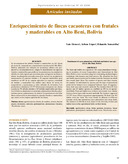Enriquecimiento de fincas cacaoteras con frutales y maderables en Alto Beni, Bolivia
ISSN
1022-7482Fecha de publicación
2008Autor Corporativo
CATIE - Centro Agronómico Tropical de Investigación y Enseñanza
Tipo
Artículo
Metadatos
Mostrar el registro completo del ítemTítulo alternativo
Enrichment of cacao plantations with fruit and timber tree species in Alto Beni, Bolivia
Descripción
2 figuras, 4 tablas, 38 ref.
Resumen
Se inventariaron los árboles frutales y maderables en 162 fincas de socios de cooperativas y asociaciones cacaoteras del Alto Beni, Bolivia, utilizando dos métodos de inventario: talleres con productores y levantamientos de campo. Se identificaron las especies frutales y maderables que prefieren los productores, la cantidad de árboles de cada especie que necesitan para enriquecer sus fincas y dónde los plantarían (en cuáles usos de la tierra). Los productores mencionaron 43 especies frutales y 45 especies maderables para establecer en 895 ha de campos agrícolas. La riqueza y densidad de frutales y maderables fue similar entre fincas de socios de cooperativas y asociaciones y entre métodos de inventario. Los productores solicitaron 123.757 árboles para enriquecer sus fincas, a razón de 291 árboles frutales y 363 árboles maderables por finca. Los árboles se plantarían en cacaotales, plantaciones lineales, plantaciones puras y plantaciones de cítricos. Los productores del Alto Beni conocen bien la diversidad de especies frutales y maderables que existe en los campos agrícolas de sus fincas. The fruit and timber tree species in 162 cacao plantations belonging to members of cocoa Cooperatives and Associations in Alto Beni, Bolivia, were recorded using two contrasting methodologies: workshops with farmers and field surveys. We identified the fruit and timber species preferred by farmers and the land uses in which they would plant them. The number of species and their density, the number of individuals by species and the type of plantations preferred by farmers were compared between types of organizations, land uses and research methods. The farmers listed 43 fruit species and 45 timber species to establish on 895 ha of agricultural fields. Fruit and timber tree richness and density were similar between farm types and research methods. The farmers requested 123,757 trees, which represented approximately 291 fruit and 363 timber trees per farm. The trees would be planted in different systems: cacao, line plantations, pure plantations and citrus fields. The farmers of Alto Beni were aware of the diversity of fruit and timber trees in the agricultural fields on their farms.
Palabras clave
CITRUS, AVERRHOA CARAMBOLA, MANGIFERA INDICA, BACTRIS GASIPAES, PERSEA AMERICANA, SWIETENIA MACROPHYLLA, CEDRELA ODORATA, ARBOLES FRUTALES, ARBOLES MADERABLES, AGROFORESTERIA, HUERTOS FAMILIARES, SISTEMAS DE EXPLOTACION, UTILIZACION DE LA TIERRA, ENCUESTAS, PARTICIPACION, DIVERSIFICACION, PLANTAS DE SOMBRA, BOLIVIA, THEOBROMA CACAO,
Representación
Sede Central
Editor
CATIE, Turrialba (Costa Rica)


